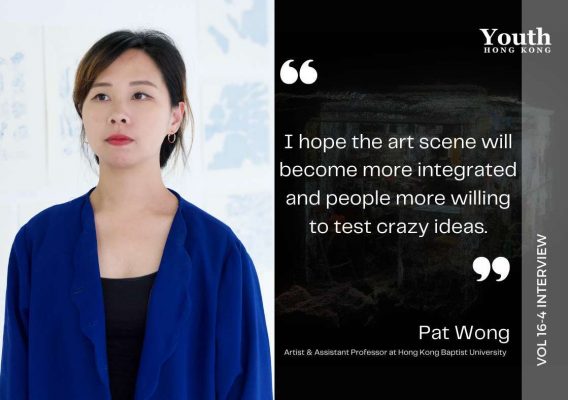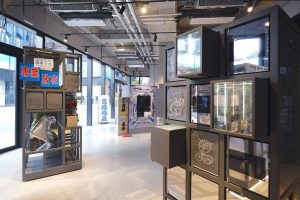//16.4 Interview: Pat Wong
With an optimistic view of the future, local artist Pat Wong spoke about Hong Kong’s creative environment, sharing her vision of a diversified and integrated arts scene involving more young people.
What would Hong Kong look like in 2099? Hong Kong artists Pat Wingshan Wong (aka Flyingpig) and Kachi Chan posed this serious question in their art project Foreseen Property 2099 (寓延). As artists and educators who care about the future of Hong Kong, they share a vision of the city’s arts scene.
Both Assistant Professors at Hong Kong Baptist University and co-founders of the speculative design project exhibited at Kai Tak, Pat and Kachi invite visitors to imagine the future of the city. In the commercial area on the site of the former airport, visitors, mostly children, act as make-believe archaeologists in the year 2099. By hammering out stone won from a claw machine, and putting it under the 3D scanning machine, they try to find out more about local shops of the past. Pat and Kachi then use multiple tools including illustration, 3D printing, and generative AI to offer a collective memory of an imagined future.
In one scenario imagined by the artists, 95-year-old Brian, who used to operate a grocery and shoe repair shop, has retired. “He donates all his machines to the Hong Kong Machine Museum, showcased in an exhibition called ‘The Light Industrial Days and Nights of Hong Kong,’ where he reunites with his old peers and colleagues in a wonderful gathering,” they write.
Shifting Attitudes
“To be an artist today, one must embrace multiple roles and responsibilities,” Pat explains. She says that in the past, to be a full-time artist was often about being a painter with superior technical skills who made a living by selling paintings. But now, the landscape has changed. “We must be adept at different things, including but not limited to writing, editing, designing, and marketing, as well as being involved in the creative process itself. A career in the art industry today demands greater flexibility and adaptability than ever before.”
In spite of the evolution of the arts scene, there is still a general perception that pursuing an artistic career involves financial insecurity. “My family told me that people who study art will end up sleeping on the streets. This is what the older generation thinks about art, especially those from working-class families,” says Pat, adding that a family’s financial status can seriously impact and limit the choices a potential artist might make. “Even in my case, I had to find a full-time 9-to-6 job after graduating with the focus on animation in order to support my family.”
This perspective is not uncommon. Research indicates that access to familial financial support is a crucial determinant when deciding whether to pursue a career as an artist. Studies from the United States and the United Kingdom confirm that individuals from wealthier families are significantly more likely to enter the creative professions.
However, attitudes are shifting. Fortunately, younger parents increasingly recognise the potential for viable careers in the arts that their children might take up. Pat expresses optimism about a more “vibrant” arts scene compared to that witnessed by previous generations, noting that many ambitious young people are now eager to initiate projects, write proposals, and apply for funding to bring their creative ideas to fruition.
Although there are always challenges, Pat believes in the adaptability of Hong Kong people and says support from stakeholders will help build a more diverse and dynamic art community. As she recalls, “When receiving funding from certain organisations, one needs to know about the target audience for a potential project, then find common interests and come up with a work that is mutually relevant. Even if it’s your own project entirely, you still need to be aware of the possible market demand.” This means that instead of waiting for resources to come your way, artists need to have vision and prospective market insight if they are to appeal to potential investors. “That’s how I think we can build up the industry,” she says.
I hope the arts scene will become more integrated and more willing to test crazy ideas.
Pat also notes the numerous arts events and government funding opportunities available to support artists. With more venues, including the West Kowloon Cultural District and The Jockey Club Creative Arts Centre – a vertical artists’ village and arts centre at the converted former Shek Kip Mei Factory Estate – emerging artists have more access to art spaces with affordable rents.
“A wave of young emerging artists is coming. I feel excited about that. The media arts tools they have and are learning are cross-disciplinary, giving them more space to explore and imagine things that we have never imagined before.”
Planting a Seed
With the arts scene becoming increasingly diverse since Pat returned from the UK to Hong Kong in 2021, she feels optimistic about the future and thinks that as the public becomes more open-minded, diversity will increase further in the years to come.
As an educator sharing her own art-creating experience with university students, how does Pat pass on her creative thinking to students? She hopes her community-led practice will serve as a powerful tool, showing students sensitivity in observation and empathy when encountering various subject matters as part of the creative process. “I hope I am planting a seed in their hearts. I don’t expect to have an immediate impact on them, but I very much hope that this seed will germinate and grow. This is how we learn.”
“I hope there will no longer be specific categories in art. Instead, I hope the art scene will become more integrated and more willing to test crazy ideas,” says Pat.
While continuing to explore society and local stories in a down-to-earth, interactive and open-ended way, she looks forward to engaging more with those who were born in a digital age. “Every individual might be capable of creating something, without limiting themselves to certain roles. The potential of a new generation is hard to imagine.” ■
References:
- Guardian: Young working-class people being ‘blocked’ from creative industries, study finds
- Hyperallergic: A Study Says High Family Income Significantly Increases Likelihood of Becoming an Artist




